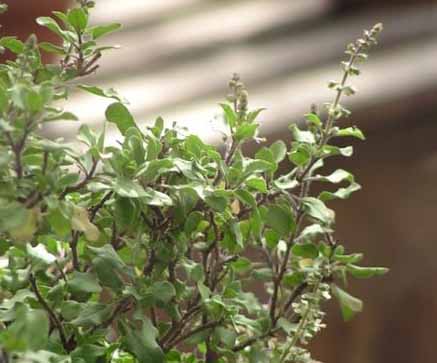 |

India's True Portal |
 |

India's True Portal |


|
 Tulasi Tulasi - the very name has sanctity about it. One doesn’t call it just ‘basil’ but Holy Basil. Ocimum Sanctum. It is a symbol of purity, divinity and health. Tulasi is believed to be the incarnation of Goddess Lakshmi and therefore incomparable. It is so much a part and parcel of Indian life and culture. Visualize this scene. First rays of morning sun filtering through the trees around. A lady wearing damp clothes after bath stands in front of the tulasi plant in her house. It could be in the front, or in the nadumuttam (inner courtyard). Droplets of water drip down intermittently from her hair. She waters the plant, stands in front of it in prayer with folded hands and does pradishana (circling around). That is the routine of many an Indian woman before she gets immersed in the daily chores, pure in body and mind. Apart from the veneration part of it, spending time before tulasi is a healthy practice. Emissions from the plant are said to purify the air around it. Skanda Purana says, "Just by touching Tulsidevi one's body becomes pure. By praying to her, all diseases practically become removed. If one waters her or makes her wet, the fear of Yamaraja (death personified) is destroyed.” The medicinal values of Tulasi have been known and used in India for thousands of years. The claimed benefits are far too many to be listed here but one must mention that it is said to reduce blood sugar and cholesterol levels. Vastu also recognizes the importance of tulasi. The plant growing in the vicinity of a house is alleged to have highly positive influence. I was surprised to learn that tulasi has religious significance in Christianity as well. It is said to have been found at Calvary where Jesus was crucified and near His tomb after the resurrection. Some Churches keep basil near the altar. It is also used in making Holy Water which is supposed to cleanse away sins and guard against evils. Christians have two saints, father and son, named Basil. Tulasi has a prominent place in the Saint Basil’s Day celebrations. The homeland of the tulasi is India, where it has been known from Vedic times. Later it spread to other countries. This Queen of Herbs is used for many culinary applications too. Ocimum tenuiflorum also known as Ocimum sanctum, and Tulas in Sanskrit and Hindi is a well known aromatic plant in the family Lamiaceae. It is known across South Asia as a medicinal plant, and has an important role within the Vaishnavite tradition of Hinduism, in which devotees perform worship involving Tulasi plants or leaves. Native to India, it is a small herb or shrub, having long lives (some plants are known to have been in the families since 3-4 generations.) The foliage is green or purple, strongly scented. Leaves have petioles, and are ovate, up to 5cm long, usually somewhat toothed. Flowers are white, tinged purple, borne in racemes. Its close cousin, the Thai Basil, Ocimum basilicum L or Ocimum sanctum, are sometimes wrongly called Hindu Holy Basil in shops and on the internet, but they can be distinguished by their very different aroma and flavour. Hindu Holy Basil is slightly hairy, whereas Thai Basil is smooth and hairless; Hindu Holy Basil does not have the strong aniseed or licorice smell of Thai Basil and Hindu Holy Basil has a spicy flavor sometimes compared to cloves The tulsi or holy basil is an important symbol in the Hindu religious tradition and is worshipped in the morning and evening by Hindus at large. The holy basil is also a herbal remedy for a lot of common ailments. Here're top fifteen medicinal uses of tulsi. 1. Healing Power: The tulsi plant has many medicinal properties. The leaves are a nerve tonic and also sharpen memory. They promote the removal of the catarrhal matter and phlegm from the bronchial tube. The leaves strengthen the stomach and induce copious perspiration. The seed of the plant are mucilaginous. 2. Fever & Common Cold: The leaves of basil are specific for many fevers. During the rainy season, when malaria and dengue fever are widely prevalent, tender leaves, boiled with tea, act as preventive against theses diseases. In case of acute fevers, a decoction of the leaves boiled with powdered cardamom in half a liter of water and mixed with sugar and milk brings down the temperature. The juice of tulsi leaves can be used to bring down fever. Extract of tulsi leaves in fresh water should be given every 2 to 3 hours. In between one can keep giving sips of cold water. In children, it is every effective in bringing down the temperature. 3. Coughs: Tulsi is an important constituent of many Ayurvedic cough syrups and expectorants. It helps to mobilize mucus in bronchitis and asthma. Chewing tulsi leaves relieves cold and flu. 4. Sore Throat: Water boiled with basil leaves can be taken as drink in case of sore throat. This water can also be used as a gargle. 5. Respiratory Disorder: The herb is useful in the treatment of respiratory system disorder. A decoction of the leaves, with honey and ginger is an effective remedy for bronchitis, asthma, influenza, cough and cold. A decoction of the leaves, cloves and common salt also gives immediate relief in case of influenza. They should be boiled in half a liter of water till only half the water is left and add then taken. 6. Kidney Stone: Basil has strengthening effect on the kidney. In case of renal stone the juice of basil leaves and honey, if taken regularly for 6 months it will expel them via the urinary tract. 7. Heart Disorder: Basil has a beneficial effect in cardiac disease and the weakness resulting from them. It reduces the level of blood cholesterol. 8. Children's Ailments: Common pediatric problems like cough cold, fever, diarrhea and vomiting respond favorably to the juice of basil leaves. If pustules of chicken pox delay their appearance, basil leaves taken with saffron will hasten them. 9. Stress: Basil leaves are regarded as an 'adaptogen' or anti-stress agent. Recent studies have shown that the leaves afford significant protection against stress. Even healthy persons can chew 12 leaves of basil, twice a day, to prevent stress. It purifies blood and helps prevent several common elements. 10. Mouth Infections: The leaves are quit effective for the ulcer and infections in the mouth. A few leaves chewed will cure these conditions. 11. Insect Bites: The herb is a prophylactic or preventive and curative for insect stings or bites. A teaspoonful of the juice of the leaves is taken and is repeated after a few hours. Fresh juice must also be applied to the affected parts. A paste of fresh roots is also effective in case of bites of insects and leeches. 12. Skin Disorders: Applied locally, basil juice is beneficial in the treatment of ringworm and other skin diseases. It has also been tried successfully by some naturopaths in the treatment of leucoderma. 13. Teeth Disorder: The herb is useful in teeth disorders. Its leaves, dried in the sun and powdered, can be used for brushing teeth. It can also be mixed with mustered oil to make a paste and used as toothpaste. This is very good for maintaining dental health, counteracting bad breath and for massaging the gums. It is also useful in pyorrhea and other teeth disorders. 14. Headaches: Basil makes a good medicine for headache. A decoction of the leaves can be given for this disorder. Pounded leaves mixed with sandalwood paste can also be applied on the forehead for getting relief from heat, headache, and for providing coolness in general. 15. Eye Disorders: Basil juice is an effective remedy for sore eyes and night-blindness, which is generally caused by deficiency of vitamin A. Two drops of black basil juice are put into the eyes daily at bedtime. DISCLAIMER: These are
only general guidelines as a first aid. It is always better to see a doctor
depending upon the intensity of the case. The views expressed above are
entirely those of the author.
.
|
 |
|
|
|
(Liveindia.com or Mr.Rajesh Chopra is not responsible for any wrong information under this site, For confirmation of any information it is recommended that you reconfirm it from your end.)
 |
 |
 |
 |
 |
 |
 |
www.liveindia.com mail:- liveindia@gmail.com |
 |
 |
 |
 |